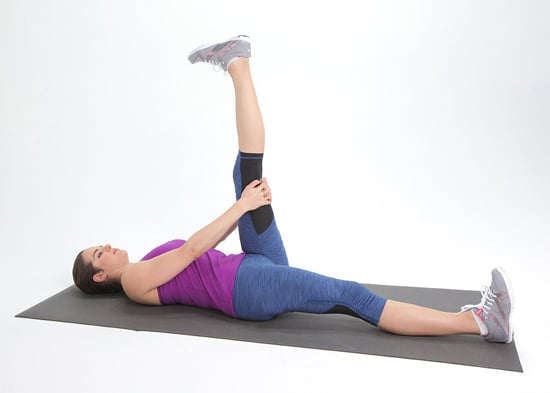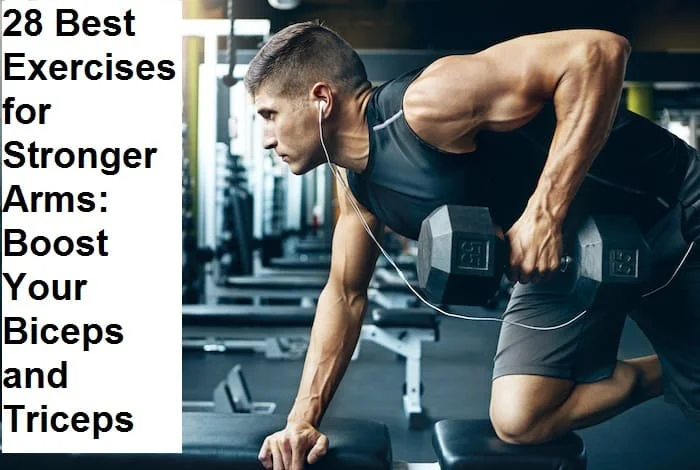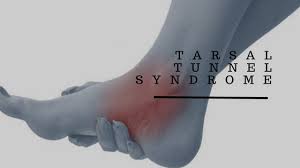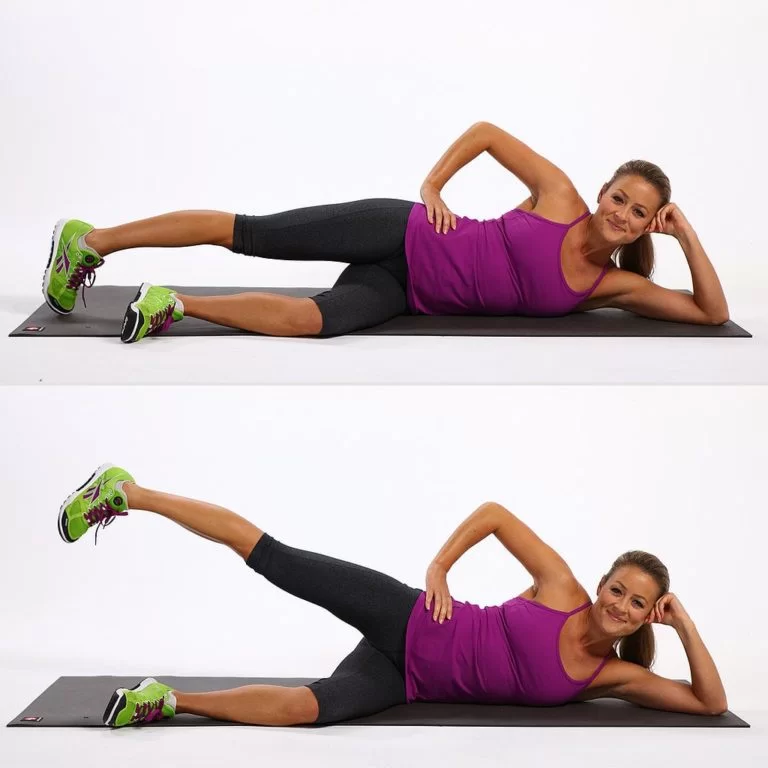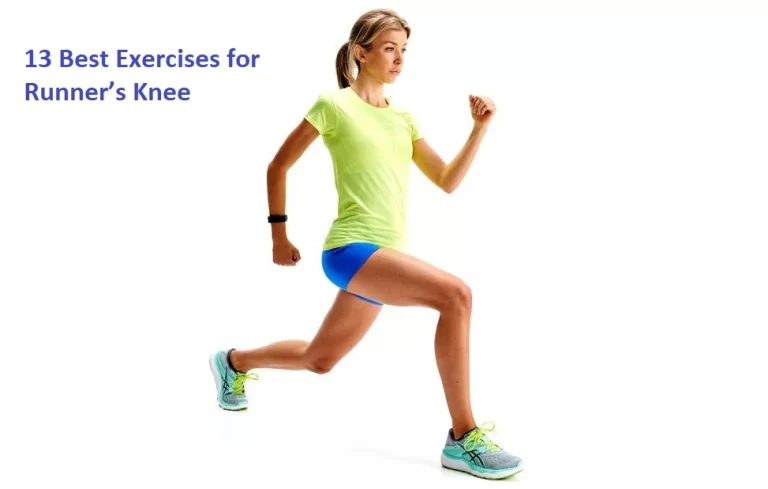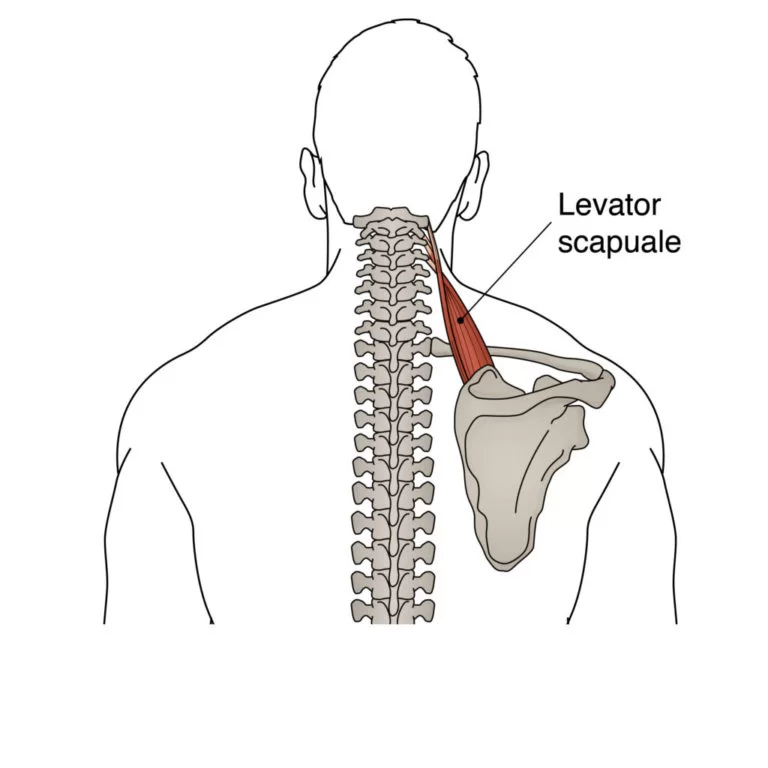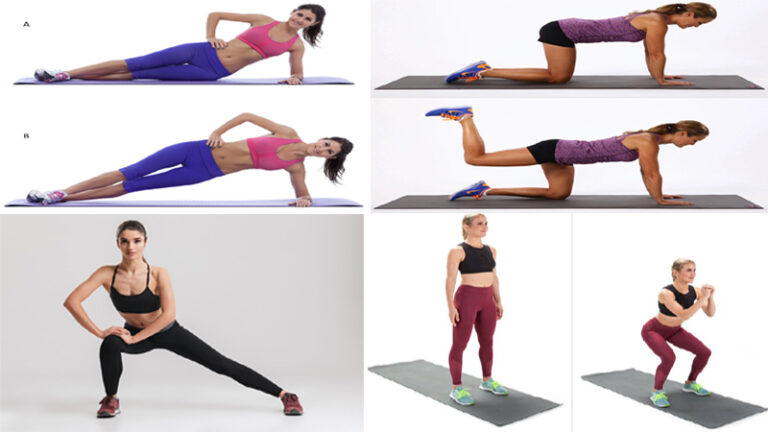Hammering the Hamstrings: A Killer Workout
Welcome to the world of hamstring exercises, where you’ll discover the keys to unlocking strength, flexibility, and performance in your legs. Your hamstrings, a group of muscles located on the back of your thighs, play a crucial role in many daily movements and athletic activities, making them a vital area to train and maintain.
Whether you’re an athlete aiming to improve your speed and agility, a fitness enthusiast looking to sculpt your lower body, or someone seeking relief from tight hamstrings and lower back pain, this guide will provide you with valuable insights and exercises to target and transform your hamstring muscles.
What is the Hamstring Muscle?
The hamstring muscle group is located at the back of the thigh and is responsible for bending the knee and extending the hip. The three muscles that make up this group are the biceps femoris, semitendinosus, and semimembranosus.
The biceps femoris muscle is the most lateral of the three muscles and is divided into a long head and a short head. The long head originates from the ischial tuberosity, which is a bony projection at the base of the pelvis, while the short head originates from the femur bone. The biceps femoris muscle inserts into the fibular head, which is a bony prominence on the outside of the knee joint. This muscle is used for flexing the knee and extending the hip.
The semitendinosus muscle is located in the middle of the hamstring group and originates from the ischial tuberosity. It inserts into the tibia bone at the inside of the knee joint. This muscle is used for flexing the knee and extending the hip.
The semimembranosus muscle is the most medial of the three muscles and also originates from the ischial tuberosity. It inserts into the tibia bone at the back of the knee joint. This muscle is used for flexing the knee and extending the hip.
Hamstring exercise
The basic bridge
The basic bridge exercise is a simple yet effective way to target the hamstrings, glutes, and lower back muscles. To perform this exercise:
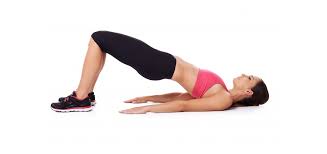
- Lie on your back with your knees must be bent and feet flat on the surface, hip-width apart.
- Put your arms at your sides with your palms facing downward.
- Engage your core muscles and squeeze your glutes as you lift your hips off the ground, keeping your feet and shoulders grounded.
- After holding, carefully bring your hips back to the floor.
- Repeat for several sets of 8-12 repetitions.
To make this exercise more challenging, you can try lifting one leg off the ground while holding the bridge position, or placing a resistance band around your thighs to add extra resistance. It is very necessary to maintain proper form throughout the exercise, keeping your back straight and avoiding any arching or twisting. As with any exercise, start with lighter weights or modifications before progressing to more challenging variations.
The single-leg bridge
The single-leg bridge is a variation of the basic bridge exercise that specifically targets the hamstrings, glutes, and lower back muscles. To perform this exercise:
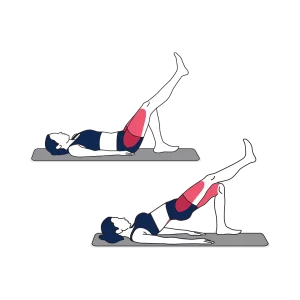
- Lie on your back with your knees must be bent and feet flat on the surface, hip-width apart.
- Lift one leg off the ground, keeping it bent at a 90-degree angle and your foot flexed.
- Put your arms at your sides with your palms facing downward.
- Engage your core muscles and squeeze your glutes as you lift your hips off the ground, keeping your supporting foot and shoulders grounded.
- After holding, carefully bring your hips back to the floor.
- Repeat for several sets of 8-12 repetitions on each leg.
To make this exercise more challenging, you can try placing a resistance band around your thighs to add extra resistance, or elevating your supporting foot on a step or bench. It is important to maintain proper form throughout the exercise, keeping your back straight and avoiding any arching or twisting. As with any exercise, start with lighter weights or modifications before progressing to more challenging variations.
Sumo squat
The Sumo squat is a variation of the basic squat exercise that specifically targets the hamstrings, glutes, and inner thigh muscles. To perform this exercise:
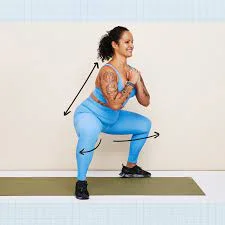
- Stand with your feet wider than shoulder-width apart, toes must be turned out at a 45-degree angle.
- Hold a dumbbell or kettlebell in front of your chest with both hands or place your hands on your hips.
- Engage your core muscles and keep your back straight as you lower your hips down towards the ground, bending your knees and keeping them in line with your toes.
- Keep your chest lifted and your weight in your heels as you lower down until your thighs are parallel to the ground.
- Pause for a few seconds, then push through your heels to stand back up to the starting position.
- Repeat for several sets of 8-12 repetitions.
To make this exercise more challenging, you can try holding heavier weights or performing the exercise on an unstable surface such as a Bosu ball. It is important to maintain proper form throughout the exercise, keeping your back straight and avoiding any rounding or hunching over. As with any exercise, start with lighter weights or modifications before progressing to more challenging variations.
Single-Leg Deadlift
The Single-Leg Deadlift is an exercise that targets the hamstrings, glutes, and lower back muscles while also improving balance and stability. To perform this exercise:
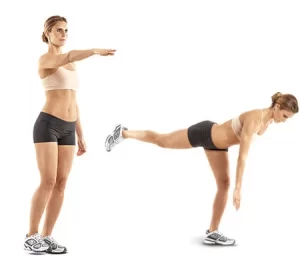
- Stand with your feet hip-width away and your weight must be put on your left foot.
- Hold a dumbbell or kettlebell in your right hand, with your arm extended down towards the ground.
- Engage your core muscles and lift your right foot off the ground, bending your knee slightly.
- Hinge forward at the hips, keeping your back straight and your left leg slightly bent, as you lower the weight towards the ground.
- Lower the weight until it reaches just below your knee, or until you feel a stretch in your hamstring.
- Pause for a few seconds, then use your hamstring and glute muscles to pull yourself back up to the starting position.
- Repeat for several sets of 8-12 repetitions on each side.
To make this exercise more challenging, you can try holding heavier weights or performing the exercise on an unstable surface such as a Bosu ball. It is important to maintain proper form throughout the exercise, keeping your back straight and avoiding any rounding or hunching over. As with any exercise, start with lighter weights or modifications before progressing to more challenging variations.
Lying Leg Curl
The Lying Leg Curl is a popular exercise for targeting the hamstrings, which are a group of muscles located on the back of your thighs. These muscles play an important role in many lower-body movements, such as running, jumping, and squatting.
To perform the Lying Leg Curl, you will need access to a machine specifically designed for this exercise. The machine typically consists of a bench with a pad positioned just above your ankles and a weight stack that provides resistance.
- To begin, adjust the machine so that the pad is positioned just above your ankles.
- Then, lie face down on the bench with your knees just off the edge and your feet hooked under the ankle pad. Grab onto the handles at the front of the machine to stabilize yourself.
- To perform the exercise, contract your hamstrings to lift your feet towards your buttocks.
- Keep your hips pressed into the bench and avoid any swinging or jerking movements.
- Pause for a moment at the top of the movement, then slowly lower your feet back down to the starting position.
- Repeat for several sets of 8-12 repetitions.
That is essential to maintain proper form throughout the exercise to avoid injury and ensure that you are effectively targeting your hamstrings. Keep your hips pressed into the bench, avoid any swinging or jerking movements, and focus on contracting your hamstrings throughout the movement.
Variations of the Lying Leg Curl can be done using resistance bands or body weights. To do this, lie face down on a mat with your legs straight and your hands placed by your sides. Lift one leg off the ground and bend your knee to bring your heel towards your buttocks. Slowly lower your leg back down and repeat for several sets of 8-12 repetitions before switching to the other leg.
Prone Hamstring Curl
The prone hamstring curl is an exercise that targets the hamstrings, the muscles located on the back of your thighs. It can be performed using a machine or with a resistance band. Here are the steps to perform a prone hamstring curl:
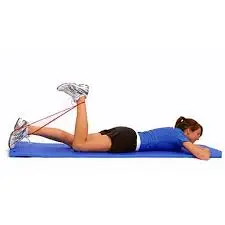
- Lie face down on a bench or mat with your legs straight and toes pointing towards the ground.
- Place a resistance band around your ankles or attach the ankle straps to a machine.
- Make sure your back is straight and contract your abdominal muscles.
- Bend your knees and bring your heels towards your glutes, while keeping your thighs on the bench or mat.
- Gradually lower your legs back down to the initiate position.
- Repeat for 10-15 reps.
- Rest for 30-60 seconds between sets.
To increase the challenge of this exercise, you can use a heavier resistance band or increase the number of reps. You can also do variations such as single-leg curls or using a stability ball.
The prone hamstring curl is an effective exercise for strengthening and toning the hamstrings, which can improve your overall lower body strength and athletic performance. However, if you have any knee or hip injuries or conditions, consult with a healthcare professional before attempting this exercise.
Reverse Plank
Reverse Plank is an exercise that targets the hamstrings, glutes, lower back, and core muscles. It is a bodyweight exercise that needs no equipment and can be performed anywhere.
To perform the Reverse Plank for hamstring, follow these steps:
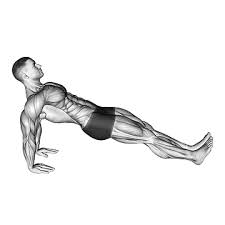
- Sit on the floor with your legs straight in front of you and your hands placed behind your hips, fingers pointing towards your feet.
- Press your palms and heels into the ground, lift your hips off the floor, and straighten your arms.
- Keep your head in line with your spine and gaze towards the ceiling.
- Engage your core muscles and squeeze your glutes to keep a straight line from your head to your heels.
- Hold this position for 20-30 seconds, then release and rest for 10-15 seconds.
- Repeat for 3-4 sets.
To increase the challenge of this exercise, you can lift one leg off the ground and hold it parallel to the other leg. This will increase the workload on the hamstrings and glutes of the supporting leg.
Reverse Plank is an effective exercise for strengthening and toning the hamstrings, glutes, lower back, and core muscles. It also improves flexibility and posture. However, if you have any back or wrist injuries or conditions, consult with a healthcare professional before attempting this exercise.
Traditional Squat
The traditional squat is a popular exercise that targets the hamstrings, glutes, quads, and core muscles. It is a bodyweight exercise that can be performed anywhere without any equipment. Here are the steps to perform a traditional squat for the hamstring:
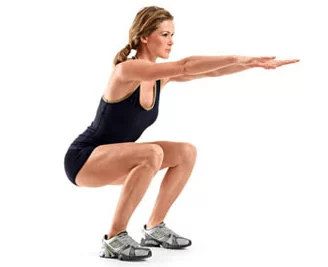
- Stand with your feet shoulder-width away and your toes pointing a little bit outwards.
- Put your hands on your hips or in front of your chest.
- Make sure to engage your core muscles and maintain your back straight.
- Lowering your body by bending your knees and pushing your hips backward as if you are sitting on a chair.
- Keep your weight on your heels and ensure that your knees do not go beyond your toes.
- Lower your body until your thighs are parallel to the ground or as low as you can go without compromising form.
- Maintain this position for a few seconds, then push through your heels to back to the starting position.
- Repeat for 10-15 reps, then rest for 30-60 seconds.
To increase the challenge of this exercise, you can hold weights or a resistance band. You can also do modifications such as sumo squats or jump squats.
The traditional squat is an effective exercise for strengthening and toning the hamstrings, glutes, quads, and core muscles. It also improves balance, flexibility, and posture. However, if you have any knee or hip injuries or conditions, consult with a healthcare professional before attempting this exercise.
Kettlebell Swing
The kettlebell swing is an exercise that targets the hamstrings, glutes, and core muscles. It is a dynamic movement that involves swinging a kettlebell between your legs and up to shoulder height. Here are the steps to perform a kettlebell swing for the hamstring:
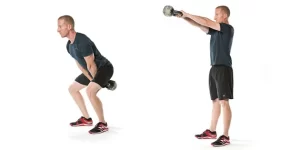
- Stand with your feet shoulder-width away and your toes pointing a little bit outwards.
- In front of you, set a kettlebell on the ground.
- Grab the kettlebell with both hands as you hinge at the hips and gently stoop your knees.
- Engage your core muscles and maintain your back straight.
- Straighten your arms as you return the kettlebell between your legs.
- Drive your hips in the forward direction and swing the kettlebell up to shoulder height.
- Let the kettlebell swing back down between your legs and repeat for 10-15 reps.
- Rest for 30-60 seconds between sets.
To increase the challenge of this exercise, you can use a heavier kettlebell or do more reps. You can also do variations such as one-arm swings or double swings.
The kettlebell swing is an effective exercise for strengthening and toning the hamstrings, glutes, and core muscles. It also improves explosive power and cardiovascular fitness. However, if you have any back or hip injuries or conditions, consult with a healthcare professional before attempting this exercise.
Hamstring stretching
The hurdler’s hamstring muscle stretch
The hurdler hamstring muscle stretch is a variation of the hamstring stretch that specifically targets the muscles located at the back of the thigh. This stretch is often used by athletes, particularly runners and hurdlers, to improve flexibility and prevent injury.
To perform the hurdler hamstring muscle stretch, follow these steps:
- Begin with sitting on the floor with your legs should be extended in front of you.
- Bend one knee and bring your foot towards your inner thigh, placing it on the floor.
- Keep your other leg extended on the floor and flex your foot towards your body.
- Do the deep inhalation and lengthen your spine, sitting up tall.
- Exhale and slowly hinge forward from your hips, reaching towards your extended foot.
- As you reach forward, bend your extended leg and bring your heel towards your buttocks.
- Hold the stretch for 15-30 seconds, feeling a gentle stretch in your hamstring muscles.
- Repeat on the other side.
The hurdler hamstring muscle stretch is particularly effective because it targets both the hamstrings and the hip flexors. By bending the extended leg and bringing the heel towards the buttocks, you also stretch the hip flexor muscles located at the front of the hip.
As with any stretching exercise, it is important to avoid bouncing or forcing the stretch, as this can cause injury. Stretching should be done gradually and gently, allowing the muscles to relax and lengthen over time. It is also important to stretch both legs equally to maintain balance and flexibility.
Standing hamstring muscle stretch
The standing hamstring muscle stretch is a simple yet effective stretch that targets the hamstring muscles located at the back of the thigh. This stretch is often used by athletes, runners, and fitness enthusiasts to improve flexibility and prevent injury.
To perform the standing hamstring muscle stretch, follow these steps:
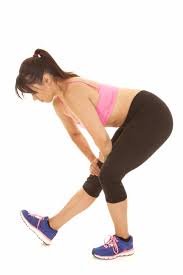
- Start with standing with your feet hip-width away.
- Your left foot should remain firmly on the ground while you advance with your right foot.
- Keep your right leg straight and flex your foot towards your body.
- Inhale deeply and lengthen your spine, standing up tall.
- Exhale and slowly hinge forward from your hips, reaching towards your right foot.
- As you reach forward, keep your back straight and avoid rounding your shoulders.
- Hold the stretch for 15-30 seconds, feeling a gentle stretch in your hamstring muscles.
- Repeat on the other side.
The standing hamstring muscle stretch is particularly effective because it can be done anywhere, anytime, without the need for any equipment or props. It is also a great way to stretch the hamstrings before or after exercise, as well as during breaks at work or school.
As with any stretching exercise, it is important to avoid bouncing or forcing the stretch, as this can cause injury. Stretching should be done gradually and gently, allowing the muscles to relax and lengthen over time. It is also important to stretch both legs equally to maintain balance and flexibility.
Hamstring muscle stretch in standing (one leg at a time)
The standing hamstring muscle stretch (one leg at a time) is a simple yet effective stretch that targets the hamstring muscles located at the back of the thigh. This stretch is often used by athletes, runners, and fitness enthusiasts to improve flexibility and prevent injury.
To perform the standing hamstring muscle stretch (one leg at a time), follow these steps:
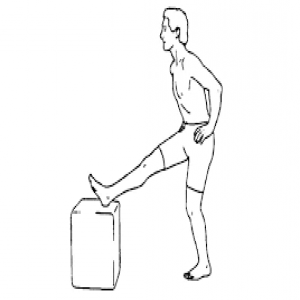
- Begin by standing with your feet hip-width away.
- Lift your right leg off the ground and place your heel on a stable surface, such as a step or bench.
- Keep your right leg straight and flex your foot towards your body.
- Inhale deeply and lengthen your spine, standing up tall.
- Exhale and slowly hinge forward from your hips, reaching towards your right foot.
- As you reach forward, keep your back straight and avoid rounding your shoulders.
- Hold the stretch for 15-30 seconds, feeling a gentle stretch in your hamstring muscles.
- Repeat on the other side.
It is very crucial to ensure that the surface you are using is stable and secure to prevent any accidents or injuries. It is also important to avoid bouncing or forcing the stretch, as this can cause injury. Stretching should be done gradually and gently, allowing the muscles to relax and lengthen over time. It is also important to stretch both legs equally to maintain balance and flexibility.
The Towel Hamstring Stretch
The towel hamstring stretch is another effective stretch that targets the hamstring muscles. This stretch is especially useful for individuals who have tight hamstrings or limited flexibility, as it allows for a deeper stretch without putting too much strain on the muscles.
To perform the towel hamstring stretch, follow these steps:
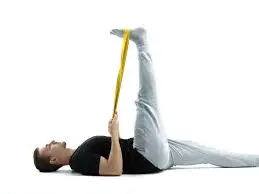
- Initiate by lying flat on your back with your legs should be extended straight out in front of you.
- Fold a towel or strap in half and loop it around the ball of your right foot.
- Hold onto the ends of the towel with both hands, keeping your arms straight.
- Inhale deeply and lengthen your spine, pressing your lower back into the ground.
- Exhale and slowly begin to pull the towel towards your body, using your arms to gently lift your leg off the ground.
- As you pull the towel towards your body, keep your leg straight and flex your foot towards your body.
- Continue to pull the towel until you feel a gentle stretch in your hamstring muscles.
- Maintain the stretch for 15-30 seconds, deep breathing and relaxing into the stretch.
- Release the towel and slowly lower your leg back down to the ground.
- Repeat on the other side.
you should avoid pulling too hard on the towel or forcing the stretch, as this can cause injury. Instead, focus on gradually and gently pulling the towel towards your body until you feel a comfortable stretch. It is also important to breathe deeply and relax into the stretch, allowing the muscles to release tension and lengthen over time.
Wall hamstring stretch
The wall hamstring stretch is another effective stretch that targets the hamstring muscles. This stretch is particularly useful for individuals who have tight hamstrings or limited flexibility, as it allows for a deeper stretch without putting too much strain on the muscles.
To do the wall hamstring stretch, follow the below steps:
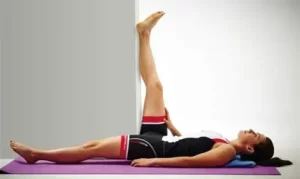
- Begin by lying on your back with your legs should be extended straight out in front of you.
- Scoot your hips towards a wall until your glutes touch the wall and your legs are extended straight up against the wall.
- Flex your feet towards your body and press your heels into the wall.
- Slowly begin to walk your hands up towards your legs, keeping your arms straight.
- As you walk your hands up, continue to press your heels into the wall and flex your feet towards your body.
- Stop walking your hands up when you feel a comfortable stretch in your hamstring muscles.
- maintain the stretch for 15-30 seconds, deep breathing and relaxing into the stretch.
- Slowly lower your hands back down towards the ground and release the stretch.
It is very necessary to avoid forcing the stretch or pushing too hard against the wall, as this can cause injury. Instead, focus on gradually and gently walking your hands up toward your legs until you feel a comfortable stretch. It is also important to breathe deeply and relax into the stretch, allowing the muscles to release tension and lengthen over time.
Seated hamstring stretch
The seated hamstring stretch is a simple and effective stretch that targets the hamstring muscles. This stretch can be done almost anywhere and is particularly useful for individuals who spend a lot of time sitting, as it helps to counteract the effects of prolonged sitting on the hamstring muscles.
To perform the seated hamstring stretching, do these steps:
- Start by sitting on the floor with your legs extended straight out in front of you.
- Lengthen your spine and engage your core muscles when you sit up straight.
- Flex your feet towards your body, pointing your toes towards the ceiling.
- Slowly begin to walk your hands down towards your feet, keeping your arms straight.
- As you walk your hands down, continue to flex your feet towards your body and keep your legs straight.
- Stop walking your hands down when you feel a comfortable stretch in your hamstring muscles.
- Maintain the stretch for 15-30 seconds, deep breathing and relaxing into the stretch.
- Slowly release the stretch by walking your hands back up towards your body.
It is very necessary to avoid forcing the stretch or pushing too hard against your legs, as this can cause injury. Instead, focus on gradually and gently walking your hands down toward your feet until you feel a comfortable stretch. It is also important to breathe deeply and relax into the stretch, allowing the muscles to release tension and lengthen over time.
Stretching the Hamstrings near the bed’s edge
The hamstring stretch on the edge of a bed is another effective stretch for targeting the hamstring muscles. This stretch is particularly useful for individuals who may have difficulty sitting on the floor due to mobility issues or discomfort.
To perform the hamstring stretch on the edge of a bed, follow these steps:
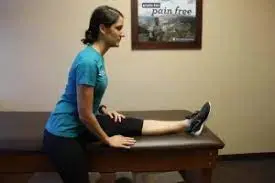
- Begin by sitting on the edge of a bed with your legs extended straight out in front of you.
- Lengthen your spine and engage your core muscles when you sit up straight.
- Scoot forward until your buttocks are at the very edge of the bed and your legs are hanging off the edge.
- Flex your feet towards your body, pointing your toes towards the ceiling.
- Slowly begin to slide your body forward, allowing your legs to hang off the edge of the bed.
- As you slide forward, continue to flex your feet towards your body and keep your legs straight.
- Stop sliding forward when you feel a comfortable stretch in your hamstring muscles.
- Maintain the stretch for 15-30 seconds, deep breathing and relaxing into the stretch.
- Slowly release the stretch by sliding your body back towards the edge of the bed.
Easy Hamstring Stretch for Athletes
The easy hamstring stretch for athletes is a simple and effective way to stretch the hamstring muscles before or after physical activity. This stretch is especially useful for athletes who engage in activities that require running, jumping, or other movements that put strain on the hamstrings.
To perform the easy hamstring stretch for athletes, do these steps:
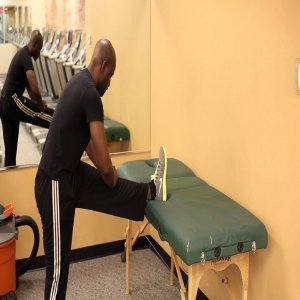
- Begin by lying on your back with your legs extended straight out in front of you.
- Place your hands behind one knee and gently pull them towards your chest.
- Keep your other leg extended straight out on the ground.
- Maintain the stretch for 15-30 seconds, deep breathing and relaxing into the stretch.
- Release the stretch and switch legs, do it again the stretch on the other side.
It is important to avoid pulling too hard on the leg or forcing the stretch, as this can cause injury. Instead, focus on gently pulling the knee towards your chest until you feel a comfortable stretch in your hamstring muscles. It is also important to breathe deeply and relax into the stretch, allowing the muscles to release tension and lengthen over time.
Partner hamstring stretching
Partner hamstring stretching is a type of stretching exercise that involves two people working together to stretch each other’s hamstrings. This type of stretching can be particularly useful for athletes who need a deeper stretch than they can achieve on their own.
To perform partner hamstring stretching, follow these steps:
- Start by sitting on the ground facing your partner with your legs extended straight out in front of you.
- Have your partner sit behind you with their legs bent and their feet flat on the ground.
- Reach forward and grab your partner’s ankles, while your partner reaches forward and grabs your ankles.
- Slowly begin to lean back, allowing your partner to pull your legs towards them.
- Maintain the stretch for 15-30 seconds, deep breathing and relaxing into the stretch.
- Release the stretch and switch positions, with the other person now stretching their hamstrings.
It is very important to communicate with your partner throughout the stretch to ensure that you are both comfortable and not pushing too hard. It is also important to avoid bouncing or jerking movements, as this can cause injury. Instead, focus on slowly and gently pulling each other’s legs towards you until you feel a comfortable stretch in your hamstring muscles.
Foam roll hamstrings
Foam rolling hamstrings is a type of self-myofascial release (SMR) technique that involves using a foam roller to apply pressure to the muscles in the back of your thighs. This technique can help to relieve muscle tension, increase flexibility, and reduce the risk of injury.
To foam roll your hamstrings, follow these steps:
- Sit on the ground with your legs should be extended straight out in front of you.
- Place the foam roller under your thighs, just above your knees.
- Use your hands to lift your hips off the ground and roll the foam roller up towards your glutes.
- When you find a tender spot or knot in your muscles, hold the pressure on that spot for 15-30 seconds.
- Slowly roll back down towards your knees, stopping again at any tender spots along the way.
- Repeat on the other leg.
It is important to avoid rolling directly over your knee joint or rolling too quickly, as this can cause discomfort or injury. Instead, focus on using slow, controlled movements and adjusting the pressure as needed to ensure that you are getting a deep but comfortable stretch.
Seated hamstring stretch (with squats)
The seated hamstring stretch with squats is an exercise that targets the hamstrings, glutes, and lower back muscles. It involves sitting on the ground with your legs extended in front of you, then performing a squatting motion while keeping your hands on the ground for support.
To perform this exercise, follow these steps:
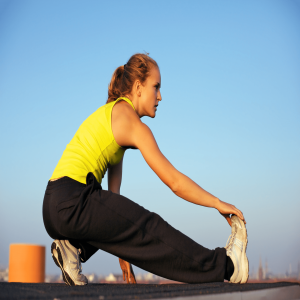
- Sit on the surface with your leg one leg should be bent and another leg should be extended straight out in front of you.
- For support, put your hands on the ground behind you.
- Slowly lower your torso towards your legs, keeping your back straight and your knees straight.
- When you feel a stretch in your hamstrings, hold the position for 15-30 seconds.
- Release the stretch and stand up.
- Perform a squatting motion by bending your knees and lowering your hips towards the ground.
- Return to the starting position and repeat the stretch-squat sequence for 10-15 repetitions.
It is very necessary to avoid bouncing or jerking movements while stretching, as this can cause injury. Instead, focus on using slow, controlled movements and adjusting the depth of your squat as needed to ensure that you are getting a deep but comfortable stretch.
Rotating toe touch
The rotating toe touch for hamstrings is an exercise that targets the hamstrings, glutes, and lower back muscles. It involves standing with your feet hip-width apart, then rotating your torso and reaching down towards your toes while keeping your legs straight.
To perform this exercise, follow these steps:
- Stand with your feet hip-width away and your arms at your sides.
- Rotate your torso to the right, reaching down towards your right foot with your left hand.
- Keep your legs straight and your back straight as you reach down towards your foot.
- When you feel a stretch in your hamstrings, hold the position for 15-30 seconds.
- Release the stretch and get back to the initiate position.
- Repeat the stretch on the other side by rotating your torso to the left and reaching down towards your left foot with your right hand.
- Continue alternating between the two sides for 10-15 repetitions.
It is very important to avoid bouncing or jerking movements during the stretch, as this can cause injury. Instead, focus on using slow, controlled movements and adjusting the depth of your reach as needed to ensure that you are getting a deep but comfortable stretch.
The staggered hamstring stretch
The staggered hamstring stretch is an exercise that targets the hamstrings, glutes, and lower back muscles. It involves standing with one foot in front of the other and bending forward at the hips to stretch the back of the legs.
To perform this exercise, follow these steps:
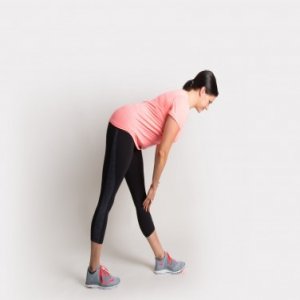
- Step forward with your right foot as you are standing with your feet hip-width apart.
- Keep your left foot behind you with the heel lifted off the ground.
- Keep your back straight while placing your hands on your hips.
- Slowly bend forward at the hips, keeping your back straight and your chest lifted.
- Reach towards your right foot with your hands, stopping when you feel a stretch in the back of your right leg.
- Hold the stretch for 15-30 seconds.
- Release the stretch and get back to the initiate position.
- Repeat the stretch on the other side by stepping forward with your left foot and reaching towards your left foot with your hands.
- Continue alternating between the two sides for 10-15 repetitions.
It is important to avoid rounding your back or bending at the waist during the stretch, as this can cause injury. Instead, focus on keeping your back straight and bending at the hips to get a deep but comfortable stretch.
The Toy Soldier hamstring stretch
The Toy Soldier hamstring stretch is an exercise that targets the hamstrings, glutes, and lower back muscles. It involves standing upright and lifting one leg straight out in front of you while keeping the opposite leg straight and reaching toward the lifted foot with your hands.
To perform this exercise, follow these steps:
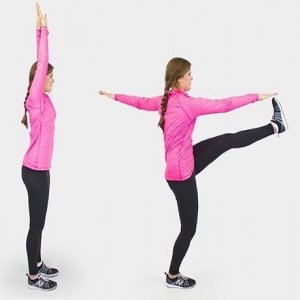
- Stand with your feet hip-width away and your arms at your sides.
- Maintaining as much straightness as you can, extend your right leg out in front of you.
- Reach towards your right foot with both hands, keeping your back straight and your chest lifted.
- Hold the stretch for 15-30 seconds.
- Release the stretch and lower your right leg back down to the starting position.
- Repeat the stretch on the other side by lifting your left leg straight out in front of you and reaching toward your left foot with your hands.
- Continue alternating between the two sides for 10-15 repetitions.
Benefits of hamstring exercise
The hamstring muscles are a group of three muscles placed at the back side of the thigh. These muscles are responsible for bending the knee and extending the hip, which are essential movements for walking, running, jumping, and other physical activities. The Toy Soldier hamstring stretch is an effective exercise that targets these muscles and provides several benefits, including:
- Improved flexibility: Regularly performing hamstring stretches like the Toy Soldier can help improve the flexibility of these muscles, which can reduce the risk of injury and improve overall mobility.
- Reduced muscle tension: Tight hamstrings can cause discomfort and pain in the lower back, hips, and legs. Stretching these muscles can help in alleviating this tension and promote relaxation.
- Enhanced athletic performance: Strong and flexible hamstrings are essential for many sports and physical activities, such as running, jumping, and weightlifting. By regularly stretching these muscles, athletes can improve their performance and reduce the risk of injury.
- Better posture: Tight hamstrings can contribute to poor posture, which can lead to back pain and other issues. Stretching these muscles can help improve posture by lengthening them and reducing tension in the lower back.
- Increased blood flow: Stretching stimulates blood flow to the muscles, which can help improve their function and promote healing after injury.
Overall, incorporating hamstring stretches like the Toy Soldier into your fitness routine can provide numerous benefits for your health and well-being. It is important to perform these exercises correctly and gradually increase the intensity to avoid injury and maximize results.
Contraindications of the hamstring exercise
While the Toy Soldier hamstring stretch can provide many benefits, there are some contraindications to be aware of. These include:
- Acute injury: If you have recently injured your hamstring or have an acute muscle strain, it is not recommended to perform this exercise until the injury has healed.
- Chronic injury: If you have a chronic hamstring injury, such as tendinopathy or a tear, it is important to consult with a healthcare professional before attempting this exercise to avoid further damage.
- Spinal issues: Individuals with spinal issues, such as herniated discs or sciatica, should avoid this exercise or modify it to avoid exacerbating their condition.
- Pregnancy: Pregnant women should be cautious when performing any exercise that involves stretching or bending, and should consult with their healthcare provider before attempting this exercise.
- Balance issues: The Toy Soldier hamstring stretch requires good balance and stability, so individuals with balance issues or who are at risk of falling should avoid this exercise or modify it to ensure safety.
It is important to listen to your body and avoid pushing yourself too hard when performing any exercise. If you experience pain or discomfort during the Toy Soldier hamstring stretch, stop immediately and consult with a healthcare professional.
FAQ
What are the benefits of hamstring muscle exercises?
Hamstring muscle exercises can improve flexibility, reduce the risk of injury, improve athletic performance, and enhance overall lower body strength.
What are some other hamstring exercises besides the Toy Soldier stretch?
Other hamstring exercises include deadlifts, hamstring curls, lunges, and squats.
How often should I do hamstring exercises?
It is recommended to incorporate hamstring exercises into your workout routine 2-3 times per week.
Can I do hamstring exercises if I have a previous hamstring injury?
It is necessary to consult with a healthcare professional before performing hamstring exercises if you have a previous injury. They can give proper guidance on proper form and modifications in order to prevent further injury.
Can hamstring exercises help with back pain?
Yes, strengthening the hamstrings can help alleviate back pain by improving posture and reducing strain on the lower back.
What equipment do I need for hamstring exercises?
Some exercises, such as hamstring curls, require gym equipment. However, many hamstring exercises can be done with just your body weight or basic equipment such as dumbbells.
How long time does it take to get results from hamstring exercises?
Results may vary depending on your fitness level and frequency of exercise, but you may start to see improvements in flexibility and strength within a few weeks.
Can hamstring exercises help with running?
Yes, strong hamstrings can improve running performance by increasing stride length and reducing the risk of injury.
Are there any specific stretches I should do before and after hamstring exercises?
Yes, it is important to stretch the hamstrings before and after exercise. Some effective stretches include the standing hamstring stretch, seated forward fold and lying hamstring stretch.

